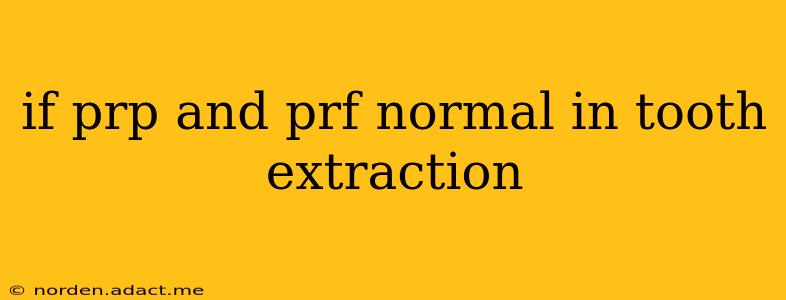Is PRP and PRF Normal in Tooth Extraction? Understanding Platelet-Rich Therapies in Oral Surgery
The use of platelet-rich plasma (PRP) and platelet-rich fibrin (PRF) in tooth extraction is becoming increasingly common, but many patients wonder if their inclusion is standard procedure. The simple answer is: no, PRP and PRF are not standard or "normal" procedures in every tooth extraction. Their use depends on several factors, including the complexity of the extraction, the patient's overall health, and the surgeon's preference and expertise.
Let's delve deeper into understanding PRP, PRF, and their role in tooth extractions:
What is PRP (Platelet-Rich Plasma)?
PRP is a concentration of platelets derived from your own blood. Platelets contain growth factors, proteins that stimulate tissue regeneration and healing. In oral surgery, PRP is injected into the extraction socket to promote faster healing, reduce post-operative pain and inflammation, and potentially improve bone regeneration.
What is PRF (Platelet-Rich Fibrin)?
PRF is similar to PRP, but it's prepared differently and contains a fibrin matrix. This matrix acts as a scaffold, providing a structure for cell growth and improving the delivery of growth factors to the extraction site. This can lead to enhanced healing and bone regeneration compared to PRP alone.
Why Would a Dentist or Oral Surgeon Use PRP or PRF in a Tooth Extraction?
Several reasons might justify the use of PRP or PRF in a tooth extraction:
- Complex Extractions: For impacted wisdom teeth or other difficult extractions resulting in significant bone or tissue damage, PRP/PRF can help accelerate the healing process and minimize complications.
- Socket Preservation: In situations where bone grafting is needed after extraction (e.g., before dental implant placement), PRP/PRF can enhance bone regeneration, improving the success rate of the subsequent implant.
- Reduced Post-Operative Complications: Studies suggest that PRP and PRF can reduce post-operative pain, swelling, and dry socket (alveolar osteitis), a painful complication that can occur after tooth extraction.
- Faster Healing: The growth factors in PRP and PRF promote faster tissue repair, leading to quicker recovery times for patients.
When is PRP or PRF Not Used in Tooth Extraction?
In many straightforward extractions, particularly those involving single, easily removed teeth with minimal bone loss, the use of PRP or PRF might not be necessary. The body's natural healing mechanisms are often sufficient for uncomplicated extractions. The cost of these procedures is also a factor; they are not covered by all insurance plans.
Are There Risks Associated with PRP and PRF?
While generally considered safe, PRP and PRF are not without potential risks. These include:
- Minor Bleeding or Bruising: At the injection site.
- Infection: Although rare, infection is a possibility with any surgical procedure.
- Allergic Reaction: Although unlikely, as the materials come from the patient's own blood.
What Should I Ask My Dentist or Oral Surgeon?
If you're considering PRP or PRF for your tooth extraction, discuss the following with your dentist or oral surgeon:
- Is it necessary for my specific case? This will depend on the complexity of the extraction and your individual health status.
- What are the potential benefits and risks? A thorough discussion of the advantages and disadvantages is crucial.
- What is the cost, and is it covered by insurance? Understanding the financial implications is important before proceeding.
- What are the alternatives? Your dentist or surgeon should explain other options and the expected outcomes.
In conclusion, while not a standard part of every tooth extraction, PRP and PRF can be valuable tools in certain situations. Whether they are appropriate for you will depend on several factors best determined through a consultation with your dental professional. Open communication with your dentist or oral surgeon is key to making an informed decision about your treatment.
